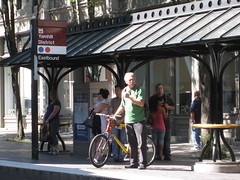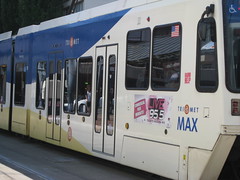FTA has upcoming listening sessions and webinars about civil rights and environmental justice. The listening sessions will discuss the proposed circulars about those topics.
National Transit Institute
Strollers, Carts, and Other Large Items on Buses and Trains (TCRP Synthesis 88) - webinar - Nov. 17, 2011. This webinar will highlight practices implemented by transit agencies to manage the capacity on vehicles carrying customers with large items, including wheelchairs; Segways; scooters and other mobility aids; strollers; bicycles; luggage, and miscellaneous items, such as skis and dog carriers. A review of the various types of transit vehicles and modifications agencies have made to their vehicles to accommodate large items will be discussed.
Managing Community Mobility - various dates to March 2012.
Comprehensive ADA Paratransit Eligibility - various dates to March 2012.
Community Transportation Association of America
CTAA Train-the-trainer for driver training, safety and security, and transportation solutions coordinator work. Visit CTAA's training page for more information.
Easter Seals Project ACTION
Accessible Transportation Coalitions Initiative - currently accepting applications. ESPA will select 10 communities through a competitive application process to participate. ATCI is a systems change model designed to improve accessible transportation options for people with disabilities. Selected communities will receive on-site facilitation and targeted technical assistance during a two-day event to learn the ATCI model and develop an accessible transportation plan. ESPA will continue to provide targeted technical assistance over the subsequent year while communities implement this plan.
[Portland light rail station with biker waiting for the train.]
Misconceptions about Livability
A new report from the Federal Highway Administration (FHWA) looks at perceived barriers to livability projects in rural, tribal and other types of areas. The Regional Livability Workshops report summarizes five workshops held across the country and suggests strategies
"to raise awareness of transportation linkages to livability, and to provide resources to practitioners and the public to more effectively consider livability issues within the Federal transportation planning process."
While most communities do have a set of goals or vision statements, workshop participants noted that the most effective visions are those that emerge from a collaborative visioning, planning or scenario development process. Participants noted quite often, these efforts include a strong outreach process that brings together both multidisciplinary interests as well as public and private constituencies. These processes can spur lasting relationships and coalitions that ultimately help create local keepers of the vision. It was also noted when a strong vision is present, project prioritization and project delivery methods can demonstrate clear policy choices between various alternatives. This direct link helps foster identification and implementation of transportation investments in support of community goals.
Community goals reflect the unique character, values, and priorities of a given place. Participants discussed the need to better align regional, State or Federal goals in transportation and mobility with local community goals. One strategy includes documenting existing goals at each level (Federal, State, regional and local) or across differing agencies and identifying where commonalities or conflicts exist. This can help to understand the tradeoffs or policy issues that need to be considered to more effectively align transportation priorities with local livability goals.
Livability TA
Environmental Protection Agency
EPA’s fall 2011 Request for Letters of Interest (PDF: http://www.epa.gov/smartgrowth/pdf/buildingblocks_2011_rfli.pdf) for direct assistance from the agency is now open. EPA will be accepting letters of interest for the next round of Building Blocks for Sustainable Communities from September 28 to October 28, 2011. Subsequent application periods will depend on budget constraints and will be announced on the Smart Growth page.
Local Stories
Twitter brings interesting stories to me and succinctly exposes my brain to useful and inexpensive tools for transit and other mobility options. This article from the Tennessean, More Cyclists, Walkers Counted in Middle TN, demonstrates that a cheap, volunteer tool can provide a snapshot of how people travel at what locations. Since a pedestrian-friendly street network is essential to transit, a one-day audit in a Tennessee community supplied useful information about where people are willing to walk and bike. Although biking is not an option for many handicapped individuals and is not a preference for many others, the bicycling rate is an indicator of how safe the street network feels to non-auto users.
Th Broome County, New York area (Binghamton area) is creating a one-call transportation center. This week, CTAA hosted a Transportation Solutions training, which was covered in the local news. The Broome-Tioga Mobility Management Project (BTMMP) call center will be housed at the local United Way. The BTMMP partnership was created to help meet the need for increased transportation services in both Broome and Tioga Counties. BTMMP will help those in need to arrange and coordinate transportation using all available resources. The BTMMP partners have been planning the project since December 2010.
BTMMP is a multi-agency partnership funded in part by the Community Foundation for South Central New York; the AmeriCorps National Service Program; Tioga Transport, Inc.; and with in-kind contributions from BTMMP partner organizations.
Food for thought: One thing I noticed in reading a local article about transportation options desired in a rural community was that the meeting to air the community's wish list was taking place on a weekday morning during traditional work hours. Well-organized advocates and staff of government organizations were expected. No mention was made of remote access or feedback or why a time that would exclude most working people would be chosen.
[Portland light rail on a Saturday morning.]






No comments:
Post a Comment